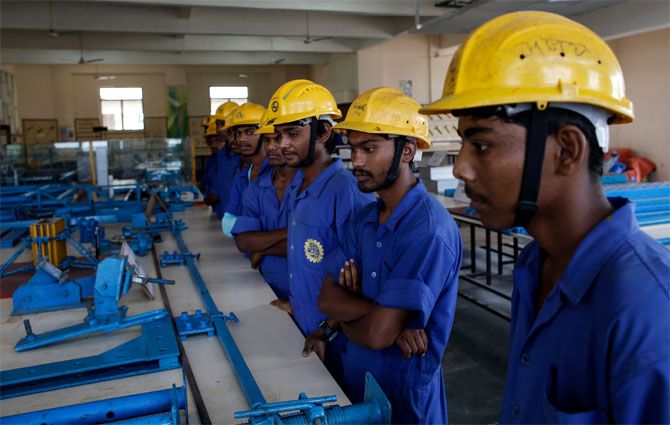'From the time India liberalised in the 1990s, the government has policies are for facilitating the growth of the manufacturing sector.'
'The policies were put in the hope that growth of the manufacturing sector will lead to increased employment,' points out Chidambaran G Iyer, Senior Fellow, Pahle India Foundation.

With more than a million added to the labour force every month, Indian policy makers have the unenviable task of creating jobs for such a humungous addition.
In addition, it is also a known fact that agriculture employs almost 50 per cent of the labour force but adds around 15 per cent to our value added (constant prices for FY18).
Thus, there is also the pressing need to increase agriculture productivity by releasing labour from farms to other productive sectors of the economy.
The prescribed economic model is to release the surplus labour into a thriving manufacturing sector -- a route that has been successfully followed by few Asian countries.
The contribution of the manufacturing sector to overall value addition in the economy at around 18 per cent has scope for improvement.
From the time India liberalised in the 1990s, the government has policies that at least on paper are for facilitating the growth of the manufacturing sector.
The policies were put in the hope that growth of the manufacturing sector will lead to increased employment.
To its credit, the manufacturing sector growth has responded positively to the policies - for example from a value addition of Rs 14 trillion in FY12 to almost Rs 22 trillion in FY18.
However, the growth in sector seems to have not led to a commensurate increase in employment; as per Annual Survey of Industries (ASI) data total persons engaged in manufacturing increased from 13 million in FY 12 to 14 million in FY16.
This has led to many scholars discussing the phenomenon of jobless growth.
To understand the Indian manufacturing context, we looked at the ASI data (FY01 to FY16) collected by the government of India.
At the national level, capital intensity in FY16 has doubled to that in FY01.
Capital intensity was defined as the ratio of real fixed capital to the total persons engaged.
This clearly tells us that at the national level manufacturing firms in the country have sought productivity improvements through investment in capital than employing more labour.
The change in capital intensity for Gujarat -- a state where manufacturing has consistently been around 25 per cent of the net state domestic product -- has also doubled during this period.
All states have witnessed this trend of increasing capital intensity; this is in line with the global trend where manufacturing has veered towards capital intensive technology.
However, increasing capital intensity of the manufacturing industry has not translated into an automatic rise in the relative contribution of manufacturing in the respective net state domestic product.
Some states have witnessed increase, others have seen their manufacturing contribution stagnate, while a few -- especially the mining state of Jharkhand -- have seen a drop.
The learning for policy making is clear that our formal manufacturing has been now for over a decade-and-a-half following a capital-intensive strategy despite which it has not been successful in increasing its relative share of output.
Changing nature of technology in our manufacturing implies that the employment ratio -- in terms of number jobs in the economy created for per rupee of investment in manufacturing -- plausibly may have reduced.
In other words, too much dependence on the manufacturing sector to employ the fresh additions into the labour force can be a bit stretched.
Now that agriculture and manufacturing are ruled out, the only sector that can bail India out, given the urgent need for jobs, is the services sector.
In the services sector, two industries that seem to have the potential to generate jobs at the required pace are tourism and entertainment.
It has been shown that one dollar spent in travel and tourism generates more total economic output than the average dollar spent in the economy as a whole.
India with its rich and varied cultural history has hardly been explored as a tourist destination, thus is a low hanging fruit.
Similarly, given our diversity and varied tastes, media and entertainment industries provide great scope for expansion and employment generation.
Our huge population becomes an asset for the media and entertainment industry and thus we need to tap it for the employment gains it offers.
It is high time that our policy makers give the same importance to these sectors as they accord to manufacturing.










